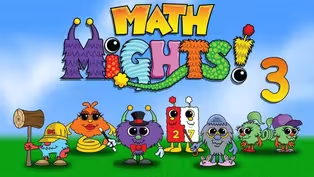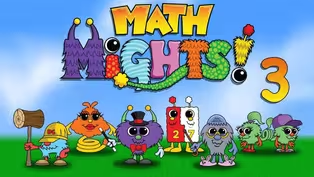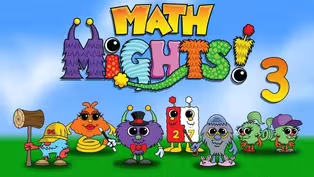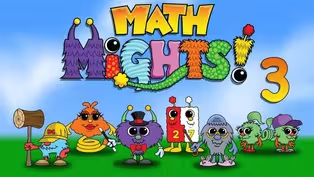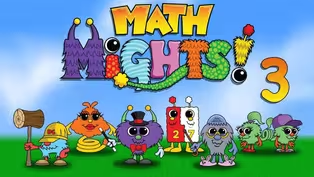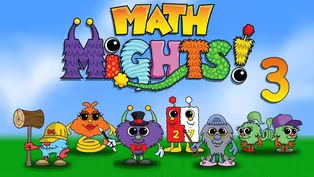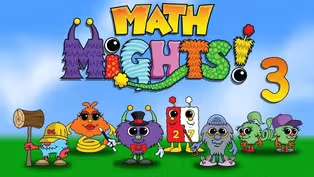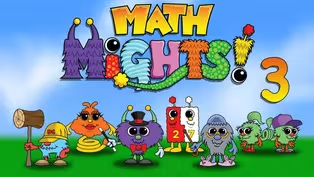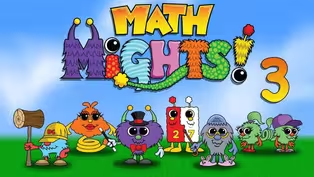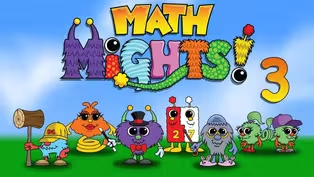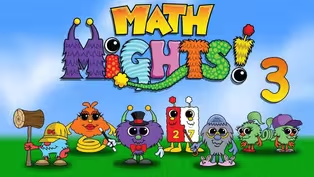Math Mights
Multiply with multiples of 10
Season 3 Episode 301 | 15m 59sVideo has Closed Captions
Learn about multiplying one-digit whole numbers by multiples of 10.
Join Ms. Askew to talk about numbers with her Math Mights friends, and then learn about multiplying one-digit whole numbers by multiples of 10.
Problems playing video? | Closed Captioning Feedback
Problems playing video? | Closed Captioning Feedback
Math Mights is a local public television program presented by Detroit PBS
Math Mights
Multiply with multiples of 10
Season 3 Episode 301 | 15m 59sVideo has Closed Captions
Join Ms. Askew to talk about numbers with her Math Mights friends, and then learn about multiplying one-digit whole numbers by multiples of 10.
Problems playing video? | Closed Captioning Feedback
How to Watch Math Mights
Math Mights is available to stream on pbs.org and the free PBS App, available on iPhone, Apple TV, Android TV, Android smartphones, Amazon Fire TV, Amazon Fire Tablet, Roku, Samsung Smart TV, and Vizio.
Providing Support for PBS.org
Learn Moreabout PBS online sponsorshipMore from This Collection
Video has Closed Captions
Join Ms. Askew for a tricky multi-step word problem with Professor Barble! (15m 59s)
Build Fraction from Unit Fractions
Video has Closed Captions
Join Ms. Askew for another multi-step word problem with Professor Barble! (15m 59s)
Video has Closed Captions
Join Ms. Askew for a division word problem with her friend Professor Barble. (15m 59s)
Video has Closed Captions
Join Ms. Askew for a division word problem with her friend Professor Barble. (16m)
Video has Closed Captions
Join Ms. Askew and Professor Barble to do a visual model with a word problem. (15m 59s)
Dividing with even larger numbers
Video has Closed Captions
Join Ms. Askew and Professor Barble to do a visual model with multiplication. (15m 59s)
Video has Closed Captions
Join Ms. Askew and Professor Barble to see if you can match visual models to word problems (15m 59s)
Dividing with Larger Quotients
Video has Closed Captions
Join Ms. Askew and Professor Barble to see if you can match visual models to word problems (15m 59s)
Video has Closed Captions
Learn about multiplying numbers larger than 20. (16m)
Video has Closed Captions
Join Mrs. Askew for a Number Talk with 2 Math Might Friends! (16m)
Multiply Teen Numbers with Larger Groups
Video has Closed Captions
Join Mrs. Askew for a Number talk with 2 Math Might Friends! (15m 59s)
Relating Multiplication and Division
Video has Closed Captions
Join Ms. Askew for a subtraction number talk with Springling! (16m)
Providing Support for PBS.org
Learn Moreabout PBS online sponsorship(playful music) - Welcome, third grade Math Might friends.
I'm so excited that you joined us today.
My name is Ms. Askew and I can't wait to have fun learning about math with you today.
But first, let's check out our plan for today.
The first thing that we're gonna do is a subtraction number talk with some of our Math Might friends.
After our number talk, we're gonna learn how to multiply with multiples of 10.
Before we get started, let's warm up our brains with a number talk, but you might be asking yourself, what is a number talk?
Well, there are three steps that you have to take when doing a number talk.
Let's have a look at those three steps.
Step number one, pose a problem.
Use an operation that you are familiar with.
Step two, try to solve the problem mentally without pencil and without paper.
Step three, share out how you solved by explaining your strategy.
Our friends Springling and DC are here to help us with our number talk.
And we might even get a visit from our friend T Pops.
Remember, Springling likes to take friendly number hops on an open number line and our friend DC, he likes to decompose numbers to rename them and make solving the problem a lot easier.
Let's look at the problem that DC and Springling would like for us to solve today, 92 minus 35.
Let's think about that number.
How would you go about solving that problem?
And remember, we're using mental math, so no paper, no pencil.
Let's take a look at how Dante used Springling to help him solve a problem on an open number line.
Starting at 35, it looks like Dante took a friendly number hop to the number 40.
As you can see, I've already started our number line.
We're gonna start at 35 and count on to the number 92.
Dante likes to take friendly hops on the number line so he chose 40 to stop.
What's the distance between 35 and 40?
Springling, can you help us with that?
Hop, Springling, hop.
The distance from 35 to 40 is five.
Starting at 40, Dante wanted to take another friendly hop to another friendly number and he chose 90.
Now you might be asking yourself why did Dante start at 40 and hop to 90?
Why didn't he just count multiples of 10, starting with 40, going to 50, then 60, 70, 80, and finally stopping at 90?
Well as you can tell, that's a lot of hops and our friends Springling, she has a curly tail and she loves to take great big hops on that open number line.
Springling, can you help us find the distance from 40 to 90?
Let's do what you do best.
Hop, Springling, hop.
The distance is 50.
Now that we are at 90, Dante wants to stop at 92.
What's the distance from 90 to 92?
Hop, Springling, hop, it's two.
Let's add these numbers together.
Five plus 50 plus two equals 57.
92 minus 35 equals 57.
Great job, Dante.
Let's take a look and see how our friend Palmer solves the subtraction problem.
Palmer says I agree with the way Dante solved the problem, but I use a different strategy.
I wonder if Palmer used Springling's strategy of hopping on a number line or did he use another one of our Math Might friends?
It looks like Palmer solved our problem with our friend DC.
DC took the number 92 and decomposed it into 80 and 12.
Let's take a closer look on our whiteboard to see if we can better understand Palmer's thinking.
Looking at the number 92, DC decomposed it to 80 and 12.
Now you may be asking yourself why didn't DC decompose it into 90 and two?
Well, if you have two, can you subtract five?
Well you can, but then we start going into negative numbers and the purpose of DC is to make subtraction easier and that's why he decomposed the number into 80 and 12.
Now we're gonna decompose the number 35.
30 and five.
That looks a lot easier.
Now let's subtract.
80 subtract 30 equals 50.
12 subtract five equals seven.
Now we're gonna add those numbers together.
50 plus seven equals 57.
92 minus 35 equals 57.
Great job, Math Mights.
All right, Math Mights.
You might be wondering why did Palmer use the strategy to decompose 92 into 80 and 12?
Well, I know a friend in Mathville who likes to rename numbers.
His name is T Pops.
He's the oldest friend in Mathville.
He wears glasses, walks around with a cane, and loves to wear his comfy bunny slippers.
Let's look at how T Pops strategy is related to how DC uses the strategy to solve subtraction problems.
T Pops likes to use the traditional method to solve subtraction problems.
He likes to rename the numbers to make it easier.
So T Pops is going to take the number 92 and rename it eight tens and 12 ones.
Hey, I can see the connection.
DC did the same thing.
He has eight tens, which is 80, and he also has 12 ones.
Now we can subtract.
12 ones subtract five ones equals seven ones.
Eight tens subtract three tens equals five tens.
That's the same way that DC solved the problem.
Great job, third grade Math Mights, making that connection with DC and T Pops.
You're getting so much better at solving those subtraction problems in different ways.
Now let's take a look at our I can statement for today.
I can multiply any one digit whole number by a multiple of 10.
For example, six groups of 90 or four groups of 30.
Let's take a look at these base 10 blocks.
What do you notice and what do you wonder?
When I looked at that picture, I noticed that the base 10 blocks were organized nice and neatly in rows.
What did you notice?
Let's see what our friends Palmer and Dante notice.
Palmer says there are 10 squares in each section.
There are four rows with three tens in each row.
Dante says there are 30 in each row.
I could skip count by 30 to find the total.
Dante and Palmer came up with some really great ideas about things that they notice.
Did you notice some things?
Let's take a look at some of the things that they may wonder.
Palmer wonders how many squares are in each row?
How many squares are in all?
Dante wonders how many squares are in each section?
What are some things that you might wonder?
How could noticing that there are groups of 10 help us find the total number of squares?
There are three groups of four tens, which is 12 tens.
We could count by tens to find the total 12 tens which equals 120.
Three groups of four equals 12, so that means 12 groups of 10 equals 120.
As you can see, third graders, multiplying by multiples of 10 can seem a little bit overwhelming, but when we take them and put them into groups, it makes it a lot easier.
Let's see if we can apply what we've learned.
Elena was helping count the money for a field trip.
There were 18 envelopes with a $10 bill in each.
How much money was there altogether?
How would we solve thinking about tens?
Let's see what T Pops thinks.
Hey, T Pops, we need your help.
Now this may take a little while because remember, T Pops is a little slow.
T Pops has a special place value board.
What do you notice about T Pops board?
I noticed that T Pops board has ten frames.
Can you see the ten frames too?
We're gonna use T Pops place value board to represent those 18 tens.
We're going to pretend like our ten discs are the $10 bills.
Now I can't put the tens disc in the ones place because it doesn't belong.
We're gonna make sure that we put our tens in the tens place.
Hey, all of my tens aren't on our place value board.
But if I look at these tens disc, I know that 10 tens equals 100.
So I can take these 10 tens and exchange them for a hundreds discs.
I'm gonna make sure I put my hundreds disc in the correct place, which is the hundreds place.
Now I can continue to place the rest of my tens discs.
Looking at our place value board, we see that we have 108 tens.
Eight tens equals 80.
10, 20, 30, 40, 50, 60, 70, 80, so the answer is 180.
18 groups of $10 equals $180.
There was $180 all together.
Math Mights, if your brain works anything like Ms. Askew's brain, using concrete objects to see a problem helps me to understand it a lot better.
Let's take a look at this picture.
Dante and Palmer use place value discs to find the value of eight groups of 30.
Let's see what Dante thought.
Dante says I counted by thirties like 30, 60, 90, 120, 150, 180, 210, 240, so it's 240.
What do you think of Dante's idea?
Let's take a closer look at how Dante counted those groups of 30.
He skip counted by thirties like 30, 60, 90, 120.
That's gonna take us a long time to count all those groups of 30.
Let's see if Palmer had a more efficient way of doing it.
Palmer thinks of it as eight groups of 30.
He says I know eight groups of three is 24.
Then I multiplied 24 groups of 10 to get 240.
What do you think of Palmer's idea?
Palmer's idea of how to solve eight groups of 30 was a little bit confusing.
And if you're like me, it helps if I can see it.
So let's try and act it out on our whiteboard.
Palmer notices the problem as eight groups of 30.
If we look at our place value disc, we see eight groups of 30.
One, two, three, four, five, six, seven, eight, but Palmer wanted to find out the actual number of discs that he sees.
He thought of it as eight rows with three discs in each row.
That's how he came up with the expression eight groups of three equals 24.
Now Palmer knows that each of those discs has a value of 10.
So if he takes 24 disc and gives them the value of 10 or multiplies that by 10, 24 groups of 10 will equal 240 and that's how he got the total number.
With the problem eight times 30, how are Dante's and Palmer's strategies the same and how are they different?
Dante and Palmer's strategies were the same because they both arrived at the same product or answer, but they were different because Dante skip counted by thirties and that took a long time.
Palmer decided to break down the problem into multiples of 10, which made it a lot easier.
Let's try another problem.
Take a look at four groups of 30.
How could we figure out the value of the disc?
Looking at our whiteboard, we have four groups of 30.
These place value disc represents that expression.
We see four groups of 30.
One, two, three, four.
We want to find the total number of discs to help us solve this problem a little bit easier.
Let's think about it this way.
If we have four rows, how many are in each row?
One, two, three, so four groups of three equals 12.
So we have a total of 12 disc.
Now we want to find out the value of all of those disc.
We have 12 discs total, but the value of each of those discs is 10, so we want to take those 12 disc and multiply it by 10.
12 groups of 10 equals 120.
Great job, Math Mights, of learning how to do a really hard concept of multiplying groups of 10.
Now it's your turn to multiply by tens in a game called four in a row.
You did such a great job of learning how to multiply with multiples of 10.
I hope you come and join us again when we do more with math.
(playful music) - [Boy] Sis4teachers.org.
- [Girl] Changing the way you think about math.
- [Woman] This program is made possible with funding from the Michigan Department of Education, Governor's Education Emergency Funds, the state of Michigan, and by viewers like you.


- Home and How To

Hit the road in a classic car for a tour through Great Britain with two antiques experts.










Careers that Work

Support for PBS provided by:
Math Mights is a local public television program presented by Detroit PBS
